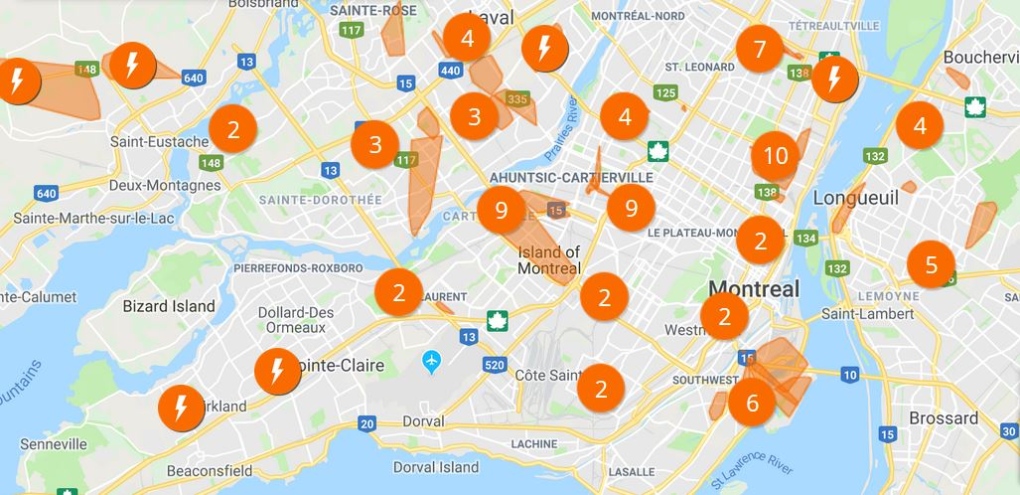The first month of 2023 marks the 25-year anniversary of the disastrous January 1998 North American Ice Storm, a crisis that left over 4 million people without power, caused approximately $6 billion USD in damages, and rendered a great deal of infrastructure inoperable in its wake.

While one might hope that these catastrophic weather events are rare, once-in-a-lifetime phenomena, reality unfortunately proves otherwise.
Here’s just a few crises in recent history that left people stranded in the dark:
The 1989 Quebec Blackout
A solar storm raging on the sun caused enough electrical interference to shut down Quebec’s entire power grid for 12 hours and incapacitated some of New England’s power supply to boot.

The Northeast Blackout of 2003
Parts of the Northeastern United States as well as most of Ontario faced a blackout which led to a loss of power and diminished transportation services. This widespread blackout was caused by a software bug at an electrical utility company which grew from a minor issue to a state-and-province-wide power outage.

2012’s Hurricane Sandy
A massive hurricane that travelled from the Caribbean to Canada, causing approximately $65 billion USD of damages.

The 2021 Texas Power Crisis
The result of three back-to-back winter storms in February. When an unprepared electricity infrastructure was met with high electric demands and sub-zero temperatures, outages were imposed to avoid overloading the state’s power grid.

Getting Ready for the Storm
Meteorologists might help predict when these weather events will occur, but little can be done to predict the large-scale damage to be left in their wake. That’s why it’s essential to always be well-prepared for the challenges that come with outages and crises. Take a look at your surroundings and think of your belongings and possessions. Are you prepared to quickly respond to a major power loss?
1. Prepare a Light Source
When you find yourself flung into dire and dark circumstances, an important first step is to establish a sense of your surroundings. There’s little you can do to protect yourself and your loved ones when you’re stranded in the dark, which is why you should always have emergency lights ready.
Emergency safety lights like the SK636V2 Rechargeable Battery Powered LED Emergency Light are the ideal alternative to other light sources such as flashlights and candles. Most flashlights vary in light strength and need constant upkeep to ensure battery and bulb lifespans, while candles pose a fire hazard, particularly during times of panic and uncertainty. Although most phones have built-in flashlights, these quickly drain essential battery life, preventing you from getting into contact with loved ones or emergency services.
Prepare dedicated emergency lights for home power outages like the SK636V2 to ensure that you aren’t relying on uncharged appliances during a surprise blackout.

Emergency lights tend to possess essential functions to help you navigate through a power outage. As soon as a power outage is detected, the SK636V2 emergency LED light automatically turns on and illuminates your surroundings. That’s because the SK636V2 is intended to set and forget: simply adjust its settings such as light intensity to your liking and plug this rechargeable safety light into an outlet.
Most importantly, this rechargeable emergency light saves you the hassle of fumbling through drawers and cabinets in the darkness for spare batteries for your flashlight or matches for your candles. Depending on your chosen settings, our rechargeable home light can last for 21.5 hours at full power, and 48 hours at half-power. Using your lights intermittently will allow them to last significantly longer.

Featuring a versatile and easily transportable design, you can easily navigate dark areas while carrying the SK636V2 emergency light. You can also use the keyholes at the back of each light to mount it on walls near your front door, allowing you to install your own impromptu emergency light fixture. If there are windows near your front door, the glow of this LED emergency light can also inform emergency services that there are occupants in your home who may require aid.
2. Determine Your Situation
Now that you’ve brightened your surroundings, take a moment to determine the cause of the outage. Is there a storm raging outside that might have damaged electrical infrastructure? Have your circuit breakers tripped? If you still have an Internet connection, consult your local outage map to see if other homes in your area have reported similar outages.

3. Temperature Control
If you’ve determined that the outage may last for some time, the next best step will be to regulate the temperature of your home and appliances. During power outages, any area of artificially generated temperature will swing the other way – cold refrigerators will get warmer, and warm rooms will get colder, especially during the winter. Luckily, there are a few options available to prevent your food and medicines from spoiling and several ways to stay warm throughout.
To keep your perishable products in good condition, start by ensuring your refrigerator and freezer doors remain shut to maintain the internal temperature. The more items you have in your fridge freezer, the longer it will remain cold. If your outage is expected to last longer than a refrigerator might be capable of keeping its temperature, consider storing your goods in a chest freezer or mini fridge that has been pre-filled with ice.

To keep yourself and your loved ones warm, wear multiple thick layers of clothing to insulate your body temperature and remain in a room insulated from the elements. Now would be a good time to make use of a fireplace if you have one, but be sure to have stocked up on wood beforehand and cleaned its chimney flue. You can also use a properly ventilated non-electric standby heater.
Should you plan to use an external generator, it is essential that the generator is outside or properly ventilated. Otherwise, you run the risk of carbon monoxide seeping into your enclosed environment, which can lead to life-threatening results.
4. Survival Kit
If an outage takes longer than expected to recover from, or should you find yourself in the need to evacuate, it would be useful to have a survival kit consisting of the essentials ready. Some key items to prepare are:
- Water: Most people need at least 2L of water a day, so plan accordingly.
- Food: Emergencies are when non-perishable foods become your friend. Anything From canned foods to energy bars to dried fruits and meats should be adequate, so long as you replace them once per year.
- Can opener: This one’s a bit self-explanatory.
- Basic sanitation products: When nature’s call consists of a storm that makes your home uninhabitable, you best be well-prepared to answer it.
- First aid kit: Should the cause of an outage or evacuation be a storm, flood, earthquake, or otherwise hazardous situation, a first aid kit is essential to face the risks that come with exposure to such conditions. Make sure it’s well-stocked and easily transportable.
- Contact information: In times of stress, it can be easy to forget or misplace contact information. Have a sheet of all your important contacts written down.
While you might be tempted to add more items to this bug out bag list, a survival kit that is either too big to properly store or too bulky to transport may cause more harm than good. Consider having a car emergency kit ready as well, should you find yourself in a rush to evacuate.
With these tips in mind, you can now properly prepare yourself for any crisis that may try to leave you stranded in the dark. With the SK636V2 emergency lights at the ready and the means for survival set, your home will be a beacon of safety and security in a sea of darkness.

.png)
